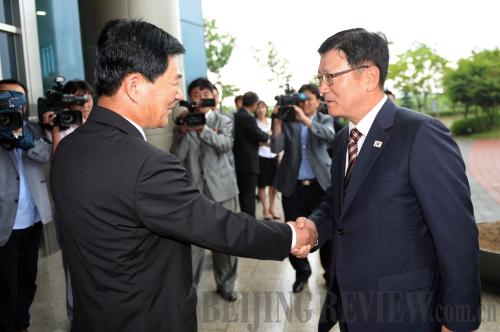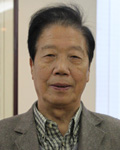|
 |
|
RESTART: South Korea's working-level chief delegate Suh Ho (right) meets with his North Korean counterpart Park Chol Su at the jointly run Kaesong industrial complex in North Korea on July 10. The complex was suspended in April amid tensions on the Korean Peninsula (XINHUA/AFP) |

After months of heightened tensions on the Korean Peninsula, North Korea began to show signs of openness to settling the nuclear matter through various platforms, including the six-party talks, which involve North Korea, South Korea, China, the United States, Russia and Japan. In the meantime, Pyongyang and Seoul restored communication lines and may soon reopen the joint Kaesong industrial complex. With these favorable new developments, all parties should focus their efforts on making progress in the denuclearization of Korean Peninsula.
Success
Four countries—South Africa, Kazakhstan, Ukraine and Belarus—have successfully sought denuclearization.
South Africa laid out its nuclear weapon agenda in the 1970s and went on to produce six nuclear warheads. However, under both domestic and international pressure brought on by its racial apartheid policy, the South African Government decided to remove its nuclear facilities in 1989. In September 1993, the International Atomic Energy Agency completed its nuclear inspections in South Africa and confirmed the complete denuclearization of the country. Independently destroying one's own nuclear weapons was dubbed the "South African denuclearization mode."
Ukraine, Kazakhstan and Belarus became nuclear weapon nations following the collapse of the Soviet Union in the early 1990s. The numbers of nuclear warheads the three countries held were 5,000, 1,400 and 81 respectively. But in the mid-1990s, the three countries decided to dismantle their nuclear weapons and deliver them together with nuclear materials to Russia for disposal. Moving nuclear weapons to other countries for destruction was then named the "Ukrainian denuclearization mode."
The two modes have different characteristics and backgrounds, but they can offer useful examples for the denuclearization of the Korean Peninsula.
The four countries initially believed that nuclear weapons would bring them national security and enhance their positions as military powers. But they soon found more harm was brought than good from their nuclear weapon programs. From the perspective of national security, a nuclear power status put those countries at risk. They not only needed to be concerned with the safety of their own nuclear facilities and weapons, but also became the potential nuclear attack targets of other nuclear powers. Moreover, from an economic perspective, the development and maintenance of nuclear arms were incredibly costly. They also invited the possibility of severe international sanctions, which could have a crippling effect on their economies.
Since denuclearization, the four countries have made much progress in economic development. South Africa is now a promising emerging economy and a member of the influential BRICS group, which also includes Brazil, Russia, India and China. Likewise, the other three countries have been gradually moving away from their past problems of economic recession, social unrest and political instability. Kazakhstan, in particular, has made great strides in economic development. From 2000 to 2012, the average annual growth rate of Kazakhstan reached 8 percent, making it one of the three fastest-growing economies in the world next to China and India. Its per-capita GDP is as high as $12,000.
|
